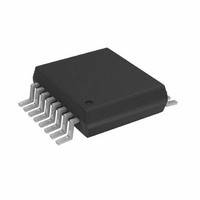AD5726YRSZ-500RL7 Analog Devices Inc, AD5726YRSZ-500RL7 Datasheet - Page 12

AD5726YRSZ-500RL7
Manufacturer Part Number
AD5726YRSZ-500RL7
Description
IC DAC 12BIT QUAD SERIAL 16-SSOP
Manufacturer
Analog Devices Inc
Datasheet
1.AD5726YRSZ-REEL.pdf
(20 pages)
Specifications of AD5726YRSZ-500RL7
Data Interface
Serial
Settling Time
9µs
Number Of Bits
12
Number Of Converters
4
Voltage Supply Source
Dual ±
Power Dissipation (max)
30mW Unipolar; 240mW Bipolar
Operating Temperature
-40°C ~ 125°C
Mounting Type
Surface Mount
Package / Case
16-SSOP
Resolution (bits)
12bit
Sampling Rate
111kSPS
Input Channel Type
Serial
Supply Current
1.25mA
Digital Ic Case Style
SSOP
No. Of Pins
16
Lead Free Status / RoHS Status
Lead free / RoHS Compliant
AD5726
TERMINOLOGY
Relative Accuracy or Integral Nonlinearity (INL)
For the DAC, relative accuracy or integral nonlinearity (INL) is
a measure of the maximum deviation, in LSBs, from a straight
line passing through the endpoints of the DAC transfer function.
A typical INL vs. code plot is shown in Figure 7.
Differential Nonlinearity (DNL)
Differential nonlinearity (DNL) is the difference between the
measured change and the ideal 1 LSB change between any two
adjacent codes. A specified differential nonlinearity of ±1 LSB
maximum ensures monotonicity. This DAC is guaranteed
monotonic by design. A typical DNL vs. code plot is shown
in Figure 8.
Monotonicity
A DAC is monotonic if the output either increases or remains
constant for increasing digital input code. The AD5726 is
monotonic over its full operating temperature range.
Full-Scale Error
Full-scale error is a measure of the output error when full-scale
code is loaded to the DAC register. Ideally, the output should be
V
full-scale error vs. temperature is shown in Figure 13.
Zero-Scale Error
Zero-scale error is the error in the DAC output voltage when
0x0000 (straight binary coding) is loaded to the DAC register.
Ideally, the output voltage should be V
error vs. temperature is shown in Figure 14.
Zero-Scale Error Temperature Coefficient
Zero-scale error temperature coefficient is a measure of the
change in zero-scale error with a change in temperature. Zero-
scale error temperature coefficient is expressed in ppm FSR/°C.
REFP
− 1 LSB. Full-scale error is expressed in LSBs. A plot of
REFN
. A plot of zero-scale
Rev. B | Page 12 of 20
Output Voltage Settling Time
Output voltage settling time is the amount of time it takes for the
output to settle to a specified level for a full-scale input change.
Slew Rate
The slew rate of a device is a limitation in the rate of change
of the output voltage. The output slewing speed of a voltage-
output DAC converter is usually limited by the slew rate of the
amplifier used at its output. Slew rate is measured from 10% to
90% of the output signal and is given in V/μs.
Digital Feedthrough
Digital feedthrough is a measure of the impulse injected into
the analog output of the DAC from the digital inputs of the
DAC, but is measured when the DAC output is not updated.
It is specified in nV-sec and measured with a full-scale code
change on the data bus.
Power Supply Sensitivity
Power supply sensitivity indicates how the output of the DAC is
affected by changes in the power supply voltage.
Analog Crosstalk
Analog crosstalk is the dc change in the output level of one
DAC in response to a change in the output of another DAC.
It is measured with a full-scale output change on one DAC
while monitoring another DAC. It is expressed in decibels.
Major Code Transition Glitch Impulse
Major code transition glitch impulse is the impulse injected
into the analog output when the input code in the DAC register
changes state, but the output voltage remains constant. It is
normally specified as the area of the glitch in nV-sec and is
measured when the digital input code is changed by 1 LSB at
the major code transition (0x7FF to 0x800 and 0x800 to 0x7FF).
See Figure 23.














